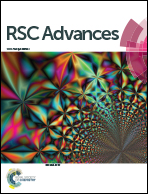Discovery of hydrazide-based pyridazino[4,5-b]indole scaffold as a new phosphoinositide 3-kinase (PI3K) inhibitor for breast cancer therapy†
Abstract
Herein, the mono and dialkylation of pyridazino[4,5-b]indole were achieved with a set of alkylating agents, including amyl bromide, allyl bromide, benzyl bromide and ethyl chloroacetate in the presence of K2CO3/acetone or KOH/DMSO. The hydrazinolysis of mono and di-esters 10 and 11 gave the target hydrazides 12 and 13, which displayed promising, potent, and significant cytotoxic activity against the MCF-7 cell line with IC50 values of 4.25 and 5.35 μm compared to that of the standard drug 5-FU (IC50 6.98 μm), respectively. RT-PCR analysis of the most active compound 12 was performed to determine its mode of action through the up-regulation of pro-apoptotic genes and inhibition of anti-apoptotic and PI3K/AKT/mTOR genes. The findings were consistent with the proposed mechanism illustrated in the in silico study. Further, the in vivo analysis exhibited its potent anti-cancer activity through the prolongation of survival parameters, and inhibition of ascetic fluid parameters in EAC-bearing mice.
![Graphical abstract: Discovery of hydrazide-based pyridazino[4,5-b]indole scaffold as a new phosphoinositide 3-kinase (PI3K) inhibitor for breast cancer therapy](/en/Image/Get?imageInfo.ImageType=GA&imageInfo.ImageIdentifier.ManuscriptID=D0RA02798G&imageInfo.ImageIdentifier.Year=2020)


 Please wait while we load your content...
Please wait while we load your content...